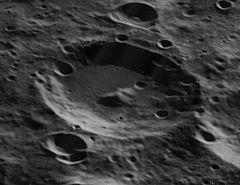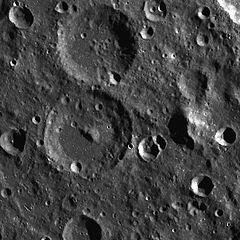 Oblique Lunar Orbiter 5 image | |
| Coordinates | 44°48′S 139°18′W / 44.8°S 139.3°W |
|---|---|
| Diameter | 66 km |
| Depth | Unknown |
| Colongitude | 141° at sunrise |
| Eponym | Henrietta S. Leavitt |

Leavitt is a crater on the far side of the Moon. It is a moderately eroded crater, but only a few minor craterlets lie along the edge and interior. Most of these features lie within the northern half of the crater, but the largest lies along the southern inner wall. The crater has a low central ridge near the midpoint. There is a patch of higher-albedo material along the eastern rim, centered on a tiny craterlet.
Nearly attached to the northern outer rim is the satellite crater Leavitt Z, a formation that appears similar to Leavitt but somewhat more worn. Less than two crater diameters to the northwest of Leavitt is the huge walled plain Apollo. To the northeast is the crater Buffon.
The crater is named after Henrietta Swan Leavitt, a Harvard astronomer. The crater was named to honor deaf people, like Leavitt, who have made substantial contributions to science. Leavitt was a major figure in the history of astronomy, providing the key to determining the size of the cosmos, and changing the face of modern astronomy. She propounded her theory while working as a $10.50-a-week assistant at the Harvard College Observatory.
Satellite craters
By convention these features are identified on lunar maps by placing the letter on the side of the crater midpoint that is closest to Leavitt.
| Leavitt | Latitude | Longitude | Diameter |
|---|---|---|---|
| Z | 42.7° S | 139.2° W | 65 km |
References
- Andersson, L. E.; Whitaker, E. A. (1982). NASA Catalogue of Lunar Nomenclature. NASA RP-1097.
- Blue, Jennifer (July 25, 2007). "Gazetteer of Planetary Nomenclature". USGS. Retrieved 2007-08-05.
- Bussey, B.; Spudis, P. (2004). The Clementine Atlas of the Moon. New York: Cambridge University Press. ISBN 978-0-521-81528-4.
- Cocks, Elijah E.; Cocks, Josiah C. (1995). Who's Who on the Moon: A Biographical Dictionary of Lunar Nomenclature. Tudor Publishers. ISBN 978-0-936389-27-1.
- McDowell, Jonathan (July 15, 2007). "Lunar Nomenclature". Jonathan's Space Report. Retrieved 2007-10-24.
- Menzel, D. H.; Minnaert, M.; Levin, B.; Dollfus, A.; Bell, B. (1971). "Report on Lunar Nomenclature by the Working Group of Commission 17 of the IAU". Space Science Reviews. 12 (2): 136–186. Bibcode:1971SSRv...12..136M. doi:10.1007/BF00171763.
- Moore, Patrick (2001). On the Moon. Sterling Publishing Co. ISBN 978-0-304-35469-6.
- Price, Fred W. (1988). The Moon Observer's Handbook. Cambridge University Press. ISBN 978-0-521-33500-3.
- Rükl, Antonín (1990). Atlas of the Moon. Kalmbach Books. ISBN 978-0-913135-17-4.
- Webb, Rev. T. W. (1962). Celestial Objects for Common Telescopes (6th revised ed.). Dover. ISBN 978-0-486-20917-3.
- Whitaker, Ewen A. (1999). Mapping and Naming the Moon. Cambridge University Press. ISBN 978-0-521-62248-6.
- Wlasuk, Peter T. (2000). Observing the Moon. Springer. ISBN 978-1-85233-193-1.